For more information about the plants or medical conditions I’ve provided a link and I am again indebted for Wikipedia and other fabulous websites for their information. As this is an educational blog I gather as much information on each plant group about their uses as possible and then try and condense this in an easy, much edited version for you.
Medical uses are in a pink background, interesting facts in blue and other uses are in green. Pictures are by Matt Summers or otherwise stated.
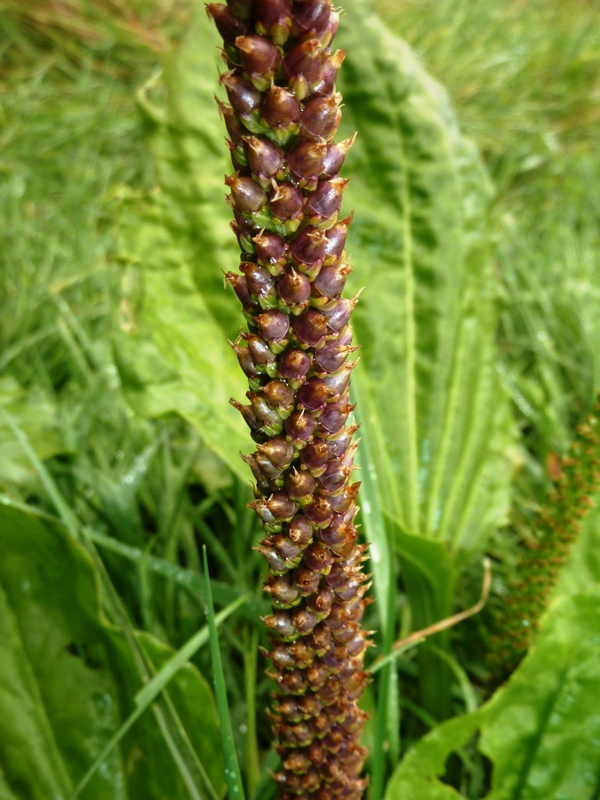
Plantago major or Greater Plantain
has 2 native subspecies in the B.I.
Some interesting information can be found in the electronic version of ‘a Modern Herbal’, first published in 1931 by Mrs. M. Grieve. This Herbal is a mine of information.The original book contains Medicinal, Culinary, Cosmetic and Economic Properties, Cultivation and Folk-Lore of Herbs.
The Great or Broad-leaved Plantain seems to have followed the migration of our colonists to every part of the world, and in both America and New Zealand it has been called by the aborigines the ‘Englishman’s Foot’ (or the White Man’s Foot), for wherever the English have taken possession of the soil, the Plantain springs up.
Our Saxon ancestors esteemed it highly and in the old Lacnunga, the Weg brade or Way bread, is mentioned as one of the nine sacred herbs. In this most ancient source of Anglo-Saxon medicine, we find this ‘salve for flying venom’: ‘Take a handful of hammer wort and a handful of maythe (chamomile) and a handful of waybread and roots of water dock, seek those which will float, and one eggshell full of clean honey, then take clean butter, let him who will help to work up the salve, melt it thrice: let one sing a mass over the worts, before they are put together and the salve is wrought up.‘
Ecology and Other Uses:
Plantain is wind-pollinated, and propagates primarily by seeds, which are held on the long, narrow spikes which rise well above the foliage. Each plant can produce up to 20,000 seeds, which are very small and oval-shaped, with a bitter taste.
It frequently grows in lawns and fields, along roadsides, and in other areas that have been disturbed by humans. It does particularly well in compacted or disturbed soils. The plant can often be spotted on old road tracks.
- The ability of plantain to survive frequent trampling and colonize compacted soils makes it important for soil rehabilitation. Its roots break up hardpan surfaces, while simultaneously holding together the soil to prevent erosion.
- The mature plant contains pliable and tough fibres that can be used in survival situations to make small cords, fishing line, sutures, or braiding.
- There is one attractive ornamental variety called Plantago major ‘Rubrifolia’. There is also a variegated leaved form, which I’ve never seen. The red colouring goes even more red in dry, sunny and poor conditions. In good soil the leaves can grow large, resembling a Hosta! I use it in prairy-style planting or even in mixed pots and hanging baskets!
- This year I grow Plantago major ‘Rosularis’ which is a strange mutant where there are no flowers but a rose-like flower of bracts!
Edible Uses:
- The leaves are edible as a salad green when young and tender, but they quickly become tough and fibrous as they get older. Many people blanch the leaves in boiling water before using them in salads.
- The older leaves can be cooked in stews.The leaves contain calcium and other minerals, with 100 grams of plantain containing approximately the same amount of beta-carotene as a large carrot.
- The dried leaves make an acceptable tea.
- The seeds are so small that they are tedious to gather, but they can be ground into a flour substitute. It is very rich in vitamin B1. The whole seeds can be boiled and used like sago.
Medicinal Uses:
- A safe and effective treatment for bleeding, it quickly staunches blood flow and encourages the repair of damaged tissue.
- Internally, they are used in the treatment of a wide range of complaints including diarrhoea, gastritis, peptic ulcers, irritable bowel syndrome, haemorrhage, haemorrhoids, cystitis, bronchitis, catarrh, sinusitis, asthma and hay fever.
- They are used externally in treating skin inflammations, malignant ulcers, cuts, stings etc.
- The heated leaves are used as a wet dressing for wounds, swellings etc.
- The root is a remedy for the bite of rattlesnakes; it is used in equal portions with white horehound or Marrubium vulgare. (Not very applicable to our British Isles I know…)
- The seeds are used in the treatment of parasitic worms.
- Plantain seeds contain up to 30% mucilage which swells up in the gut, acting as a bulk laxative and soothing irritated membranes. Sometimes the seed husks are used without the seeds.
- Distilled water made from the plant makes an excellent eye lotion.
Plantago lanceolata or Ribwort Plantain
The next common Plantain is the Ribwort Plantain which is again an attractive plant especially in combination with the dainty flower heads.
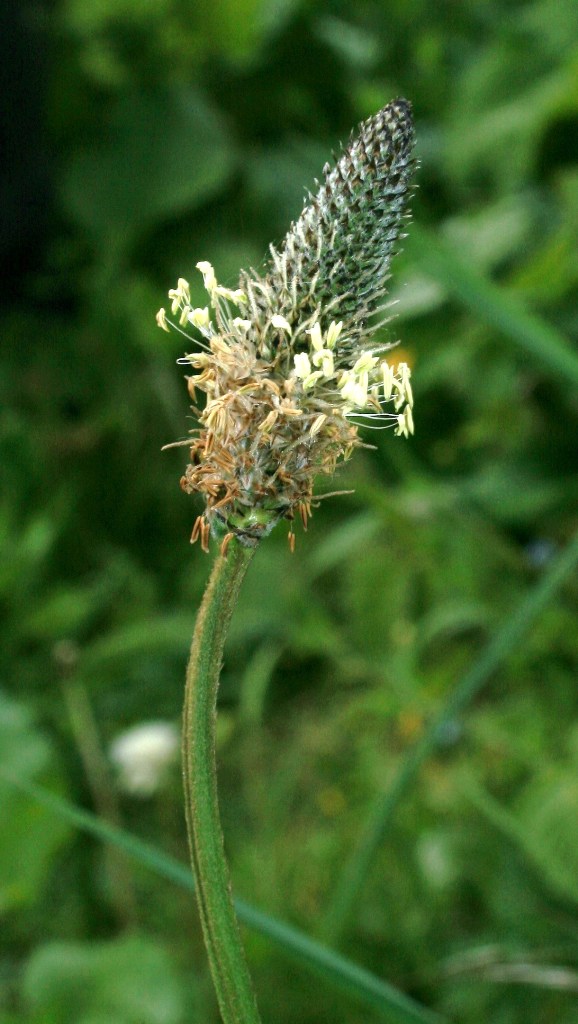
It grows anywhere in especially disturbed habitats and the long leaves can adapt by growing more flat to the ground when frequently mowed or trampled by feet or hoofs!
Interesting historical use:
In the UK and Ireland the plant is used by children to play various simple games. In Edinburgh, Scotland this game is called ‘The 1 o’clock gun’ after the gun that fires everyday from Edinburgh Castle. Writer Sean Michael Wilson notes that: “When I was a kid in Edinburgh we used it for a cute wee game called ‘The 1 o’clock gun’ – we twisted the stalk around into a kind of noose, quickly pulled it (with the left hand pulling back sharply and the right hand moving forward) and then the head of the stalk would go shooting off. We used to see how far we could get it to go – great fun.” In the West Country of England the same game is called ‘cannonballs’. Another game played with the plant in Scotland and Ireland and possibly also in England is called ‘Bishops’. This game is a bit like conkers; a child tries to knock off the head of their friend’s stalk using their own stalk, via a fast downward thrust.
Wildlife Uses:
The mode of reproduction can vary among populations of P. lanceolata. Reproduction occurs sexually, with the pollen being wind dispersed for the most part, though the plant is occasionally pollinated by bees. P. lanceolata cannot self (= reproduce asexually) in the way that many other species of Plantago can; instead, it is an obligate outcrosser.
- Plantago lanceolata is host to many different species of the order Lepidoptera. Species such as Junonia coenia, Spilosoma congrua, and Melitaea cinxia lay their eggs on P. lanceolata plants so they can serve as a food source for the larvae when they hatch.
- The iridoid glycosides in the plant leaves accumulate in the caterpillars and make them unpalatable to predators.
- Songbirds eat the seeds, and the leaves are loved by rabbits.
Edible Uses:
- Young leaves – raw or cooked.
- They are rather bitter and very tedious to prepare, the fibrous strands are best removed prior to eating.
- Seed – cooked. Used like sago. The seed can be ground into a powder and added to flours when making bread, cakes or whatever.
Medicinal Uses:
- Similar medicinal uses to the Broadleaf Plantain (P. major)
- Plantago lanceolata is used frequently in herbal teas and other herbal remedies.
- A tea from the leaves is used as a cough medicine.
- In the traditional Austrian medicine Plantago lanceolata leaves have been used internally (as syrup or tea) or externally (fresh leaves) for treatment of disorders of the respiratory tract, skin, insect bites, and infections.
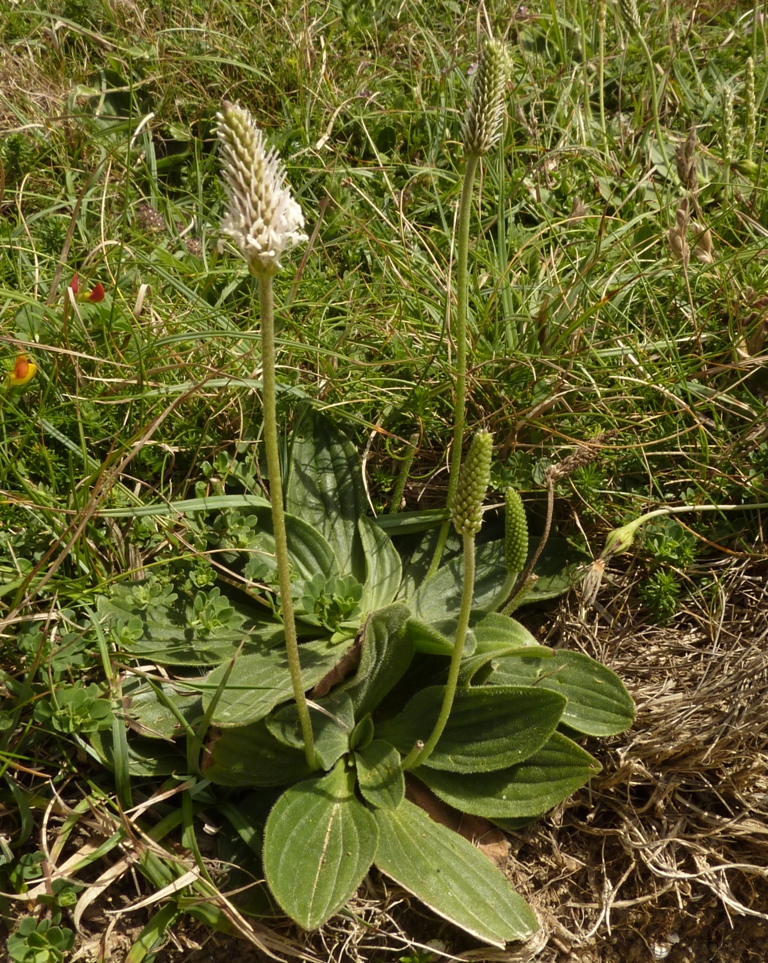
Apt scientific name, as the leaves are somewhat in between the Ribwort and Broadleaf Plantain!
The third most common plantain is probably:
P. media or Hoary Plantain
Habitat and Wildlife Uses:
Plantago media is native to Eurasia. It is native to England, but scarce in Scotland and Ireland. It is calcicole, characteristic of soils on chalk or limestone, growing in grassland, meadows, lawns and waste places.
It cannot grow in the shade. It prefers dry or moist soil. The plant can tolerate maritime exposure.
- The species is hermaphrodite (has both male and female organs) and is pollinated by Wind, flies, beetles, bees. The plant is self-fertile.
- It is noted for attracting wildlife.
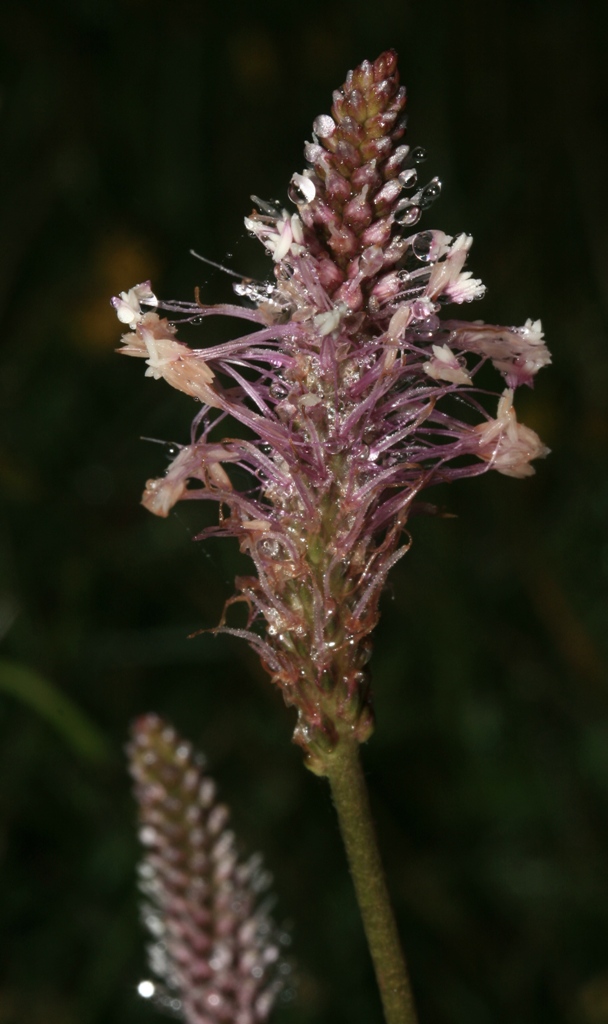
Edible Uses:
- Young leaves – raw or cooked.
- The very young leaves have a fairly mild flavour but with a slight bitterness (Ken Fern of PFAF).
- Used in salads before they become tough.
- The inflorescence is sweet and is sucked by children. (In the olden days!)
Medicinal Uses:
- The leaves are applied externally to skin inflammations, malignant ulcers, cuts etc.
- A mouthwash made from the leaves helps to relieve toothache and a distilled water is a good eyewash.
- The seeds are demulcent and laxative.
- Plantain seeds contain up to 30% mucilage which swells up in the gut, acting as a bulk laxative and soothing irritated membranes.
- Sometimes the seed husks are used without the seeds.
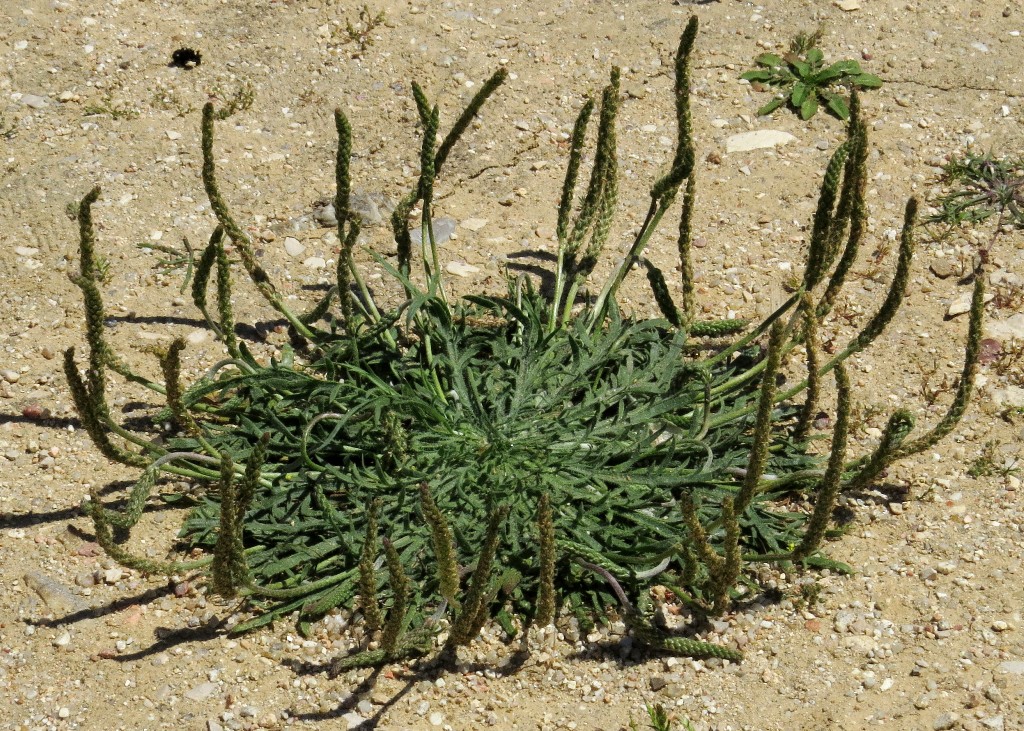
Plantago coronopus or Buck’s-Horn Plantain
This is a bit more unusual Plantain but can be found in sandy or gravelly soils and cracks in rocks, in sunny places in dry soils usually near the sea. I have also spotted it on Junction 10 of the M6 recently, which makes sense as it gets treated with salt every winter!
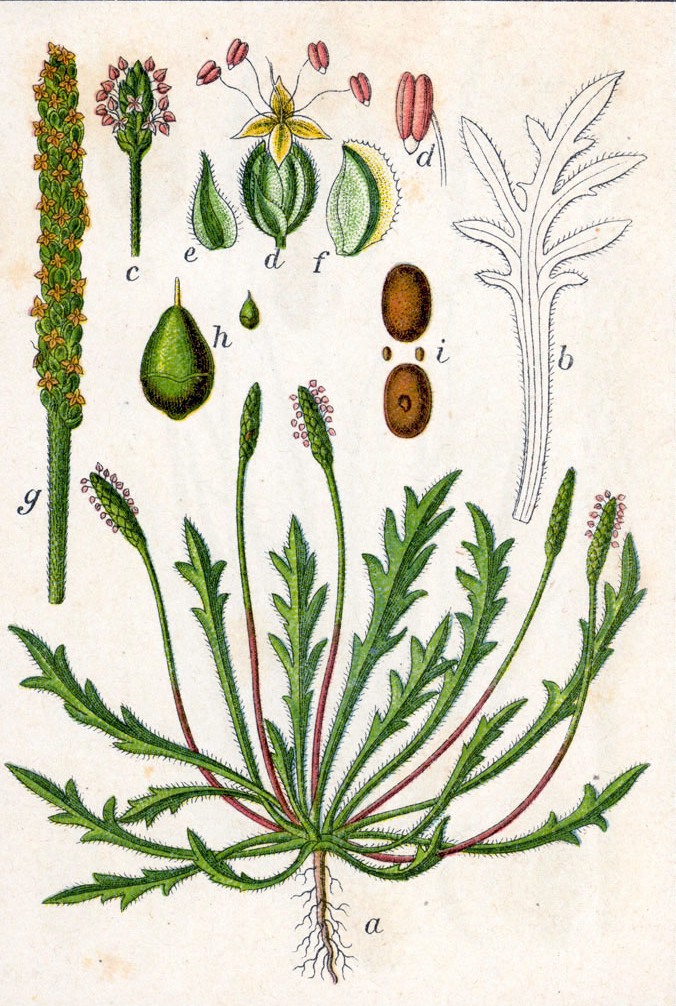
Edible Uses:
- It is grown as a leaf vegetable known as erba stella, mostly incorporated in salad mixes for specialty markets. Recently it has become popular as a frost-hardy winter crop for farmers in northern climates, and is usually grown in unheated tunnels. Have had this given to me by a good friend recently and will let you know what I think!
One of the nicer tasting members of this genus, the leaves are fairly tender and have a slight bitterness (Ken Fern PFAF). Some people blanch the leaves in boiling water for a few seconds before using them in salads in order to make them more tender.
This leaf is one of the ingredients of ‘misticanze’, a salad mixture of wild and cultivated leaves that originated in the Marche region of Italy.
Medicinal Uses:
- The leaves are antiperiodic and ophthalmic. They are used as a remedy for ague and sore eyes. Plantain seeds contain up to 30% mucilage which swells up in the gut, acting as a bulk laxative and soothing irritated membranes. Sometimes the seed husks are used without the seeds.
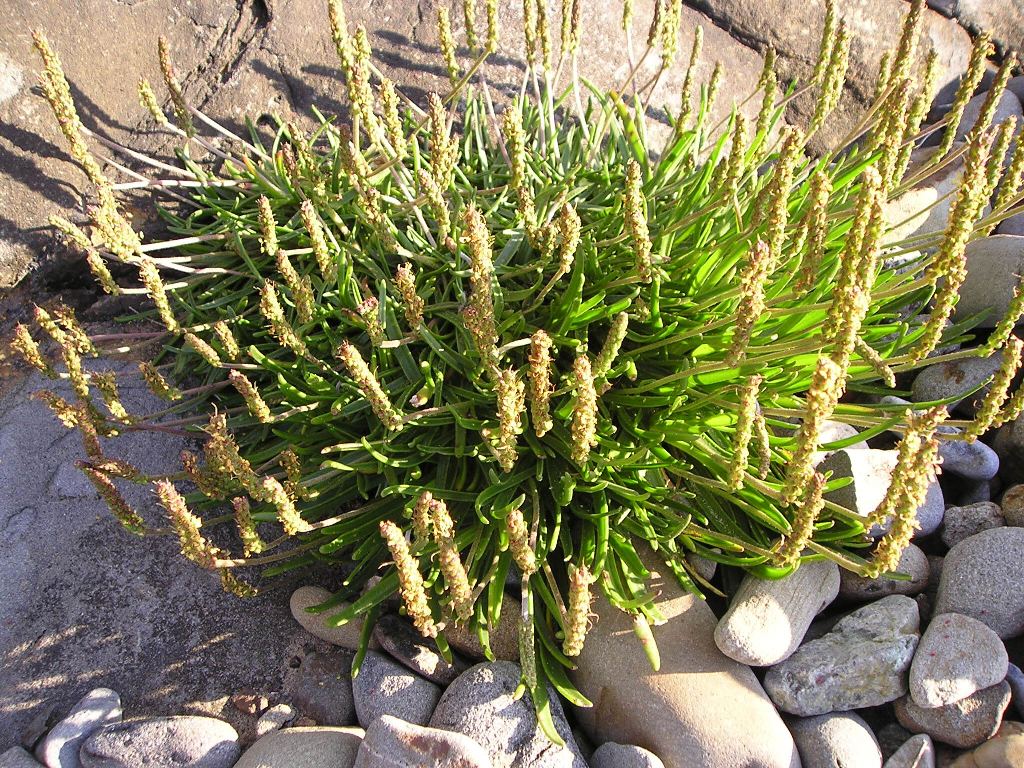
Plantago maritima or Sea Plantain
Native in salt marshes, rock-crevices and short turf near the sea, and wet rocky places on mountains; common on coast round B.I., inland on mountains, rare in inland salt marshes or by salt-treated roads.
Edible Uses:
- Young leaves – raw or cooked.
- This is one of the nicer-tasting members of the genus, the leaves are fairly low in fibres and make an acceptable addition to a mixed salad (Ken Fern, PFAF). The leaves are canned for winter use in Alaska.
- Seed – raw or cooked. The seed can be ground into a powder and used as a flour extender. The seed is very small and tedious to harvest.
Medicinal Uses:
Plantain seeds contain up to 30% mucilage which swells up in the gut, acting as a bulk laxative and soothing irritated membranes. Sometimes the seed husks are used without the seeds.
The only other genus with one species is:
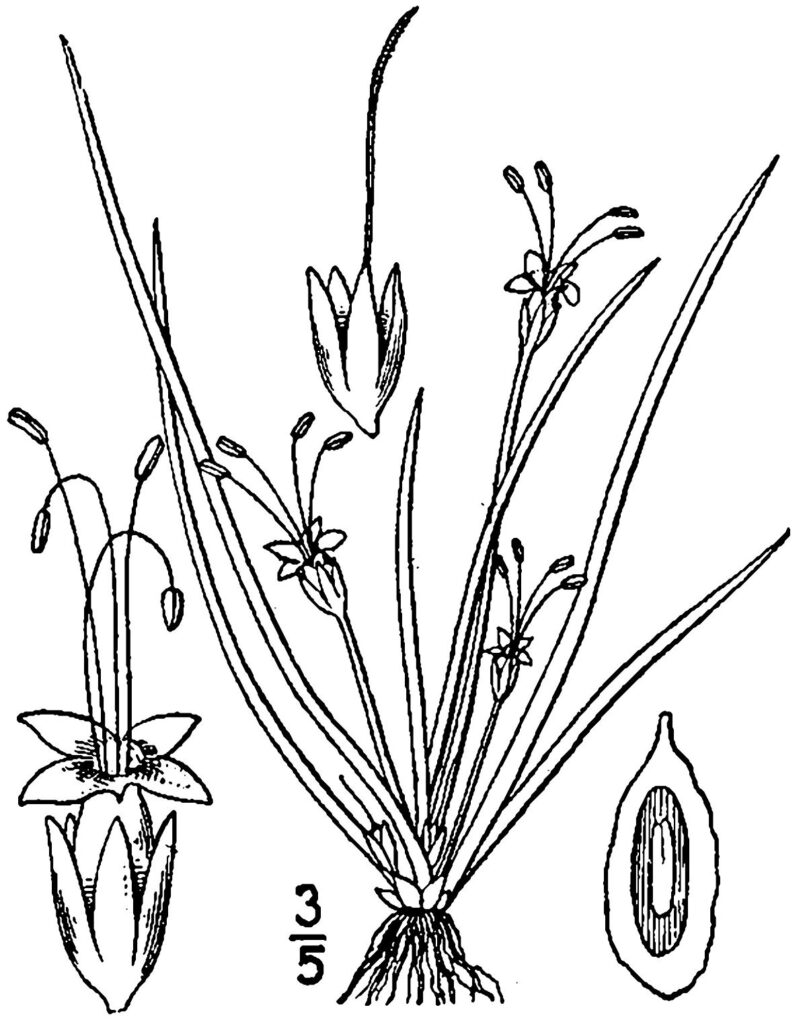
Littorella uniflora or Shoreweed
This is an aquatic species and I cannot find much information about this. Please follow the links for some pictures send in on ISpot!
